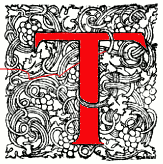
he first of two illustrations in The Welcome Guest by Arthur Hughes was for ‘The Tentmaker’s Story’ by Robert B. Brough, in the issue for 16 October 1858. Brough took as his inspiration for this poem ‘the eighth novel of the Fourth Day’ of Boccaccio’s Decameron; the story of Girolamo and Salvestra. He retold the story from the confessional perspective of the tent-maker who had married Salvestra, the tailor’s daughter, after her true love, Girolamo, the son of a cloth merchant, was sent off to Paris by his mother to forget her. In his version Brough gently mocked the hierarchy that appeared to exist between the various links in the chain of commerce and the consequent difference in status between the two lovers.
The second illustration by Hughes, in the Christmas bumber of The Welcome Guest, on 22 December 1858, was for ‘The Wedding-Rings of Shrimpington-Super-Mare’. This composite piece about wedding rings, and ‘those who wore them for better and for worse’, was by various authors including G.A. Sala, Adelaide Procter, Augustus Mayhew, John Lang, Frederick Greenwood, H. Sutherland Edwards, and Edmund Yates. A review in the Derby Mercury of 5 January 1859 (p.6) referred to the ‘Christmas Number’ of the Welcome Guest, which would, it suggested, ‘add to the cordiality of the welcome it has already ensured for itself in all quarters. It contains seven capital tales — the subjects being, as their title indicates, the history of wedding rings’; the reviewer continued: ‘The fourth ring, “Philip and Mildred,” is a beautiful love tale in verse, by Miss Adelaide Procter’.
Both of these illustrations by Hughes in The Welcome Guest are associated with the wastefulness of unfulfilled love, and both women have apparently static, passive roles. In the first illustration Salvestra stands next to a caged bird in a deliberately self-contained, isolated pose with her arms folded, and her back to the door. She sang ‘in her prison as sings a bird’; her husband appears to weep, whilst between them, peering through the half open door, Girolamo appears, stooped and leaning on a stick, with a ‘strange-cut beard and outlandish guise’ and ‘broken in health’ and mind (Welcome Guest, 16 October 1858, p. 395). In the second illustration (12), Hughes shows the young couple framed by the ‘shady limewalk’, with Mildred leaning her head against Philip’s shoulder as he places a ring into her open hand in token of his constant love; Mildred is depicted as patient and submissive to her lover.
Hughes was not at all pleased about the engraving of the second illustration as a letter to William Allingham on 5 December 1858 reveals:
If a great work called ‘Welcome Guest’, penny a week, comes your way, in the Christmas supp. - price ‘tuppence’ - you’ll find a drawing by us. Very bad in consequence of the gent having had half his face taken off in the cutting; the farthest half if you look at it. [Allingham, p.66].
Whilst neither illustration could be regarded as one of Hughes’s better designs, they both manage to convey a sense of sadness and potential loss. Miss Procter’s poetry had ‘great popular appeal’ (Lohrli, p.404), and it is probable that she came to publish in this periodical through the agency of Sala who was not only a co-author of ‘The Wedding-Rings of Shrimpington-Super-Mare’, and a fellow contributor to Household Words (as was his friend Edmund Yates), but also the first editor of The Welcome Guest. ‘Philip and Mildred’ was subsequently published in the second volume of Procter’s Legends and Lyrics (Bell & Daldy, 1861).
In an introduction to a later edition of Legends and Lyrics (Bell & Daldy, 1866), published after Miss Procter’s death, Charles Dickens referred to the first publication of her poems in periodicals such as The Cornhill, Good Words, Household Words, and All the Year Round, but no mention was made of this poem having first appeared in The Welcome Guest, and it appears to have been the first time that one of Miss Procter’s poems had been illustrated.
Last modified 24 April 2013